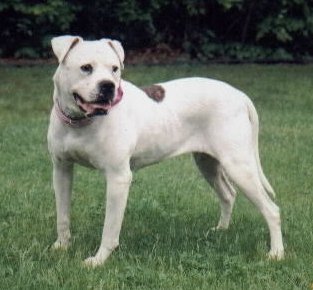
|
|
The American Bulldog is ONE breed with two written standards. |
The American Bulldog originated as a catch dog (mostly cattle) and property protection dog, in America's Southeast. He was not bred to put on threat displays or to look a certain way. But, he did need the right equipment to take care of his real bulldog duties which were confrontational personal and property protection and as a catch dog. He needed to be strong enough to put unruly bulls on the ground and athletic enough to catch hogs that were allowed to free range in a semi-wild state.
.
Temperament:
Click Here To Read More About the Temeprament Differenaces between the two types of American Bulldogs.
.
General Appearance:
The American Bulldog should generate the impression of great strength, agility, endurance and exhibit a well-knit, sturdy, compact frame with the absence of excessive bulk. Males are characteristically larger, heavier boned and more masculine than the bitches. The AB is a white or white and patched (brindle or red) dog. When patched he can range from the traditional pied markings of a patch over one or both eyes or ears, or a patch on the base of the tail, to a large saddle patch and various other patches.
.
For judging purposes, distinctions between an ideal "Standard-type" are defined in Blue Text and an ideal "Bully-type" are defined in Red Text. "Faults" are typed in Yellow Text.
.
Size:
General:
Males - 23 to 27 inches at the withers and weigh ffrom 75 to 120 lbs.
Females - 21 to 25 inches at the withers, 60 to 90 llbs.
The weight should be proportional to size.
.
Standard-type:
An ideal male should be 23 to 27 inches at the withers and weigh from 75 to 110 lbs.
Females should be 21 to 25 inches, 60 to 85 lbs.
The weight should be proportional to size.
.
Bully-type:
An ideal male should be 22 to 26 inches at the withers and weigh from 80 to 120+lbs.
Females 20 to 24 inches, 60 to 90+lbs.
The weight should be proportional to size.
.
Head:
Medium in length and broad across skull with pronounced muscular cheeks.
.
Eyes:
Any color. Medium in size. The haw should not be visible. (Haw is the lower eye lid, removed away from the eye.)
Black eye rims preferred on white dogs. Pink eye rims to be considered a cosmetic fault.
 |
 |
|
 |
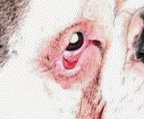 |
Muzzle:
Medium length ( 2 to 4 in.), square and broad with a strong under jaw. ** Lips should be full but not pendulous.
42 to 44 teeth.
Wry Jaw or Crooked Jaw a Serious Fault and genetic health problem.
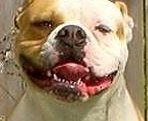 |
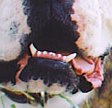 |
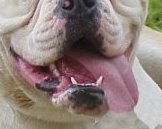 |
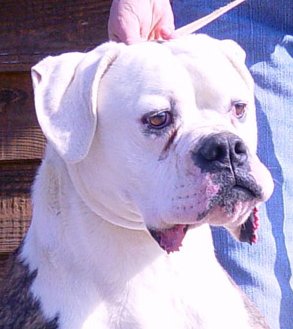 |
Standard-type:
Tight undershot (reverse scissors) preferred.
Scissors and even bites are considered a cosmetic fault.
Structural faults are a muzzle under 2 inches or longer than 4 inches, pendulous lips, less than 42 teeth, more than 1/4 inch undershot, small teeth or uneven incisors.
WE ARE IN NEED OF FOLKS WITH STANDARD DOGS TO SEND IN PICTURES OF THEIR DOGS BITE. FOR THIS PICTORIAL SECTION
|
|
|
|
|
Bully-type:
Definite undershot, 1/8 to 1/4 inch preferred. (Upto 3/4" Undershot is common in bully dogs)
Scissors or even bite is a disqualification.
Structural faults are a muzzle under 2 inches or over 4 inches.
 |
|
|
|
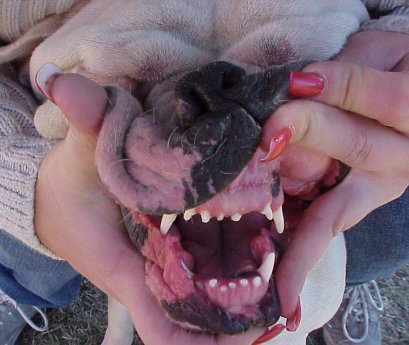 |
Missing
teeth are not a problem for the American Bulldog in the show ring. Because
the American Bulldog is a "Working" dog, the registry's don't see this
as a fault.
Some times this happens as a mishap on the personal protection training field. |
Nose color:
Black or grizzle. On black nosed dogs the lips should be black with some pink allowed.
** Nostrils should be round or open for clean breathing. Not collapsed, collapsed nostrils cause snorting, and breathing through the mouth.
A pink nose to be considered a cosmetic fault. Grizzle is considered a Red,Brown or Liver nose.
 |
 |
 |
 |
 |
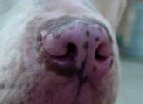 |
 |
 Open Nostriles
Open Nostriles |
Ears:
Cropped or uncropped.
Uncropped not preferred.
 Correct Ear Set
Correct Ear Set |
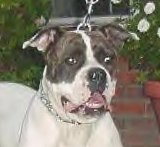 |
 |
 |
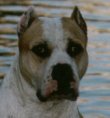 |
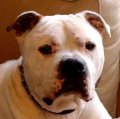 |
|
Neck:
Muscular, medium in length, slightly arched, tapering from shoulders to head, with a slight dewlap allowed.
Shoulders:
Very
muscular with wide sloping blades, shoulders set so elbows are not angled
out. (see below pics)
 |
 |
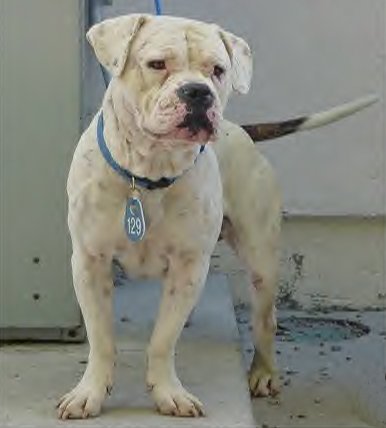 |
Chest, Back and Loin:
The chest should be deep and moderately wide without being excessively wide as to throw the shoulders out.
(see above pics)
The back should be of medium length, strong and broad. Loins should be slightly tucked which corresponds to a slight roach in the back which slopes to the stern.
Faults: Sway back, narrow or shallow chest, lack of tuck up.(see below pics)
Chest Rule of Thumb: If the dogs chest is deeper then the dogs elbow, a deep chest. If there is a gap between the dogs chest and elbow, a Shallow chest.
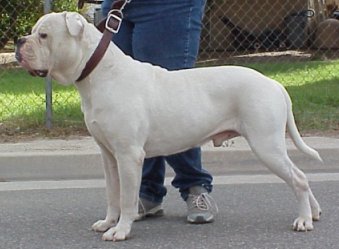 |
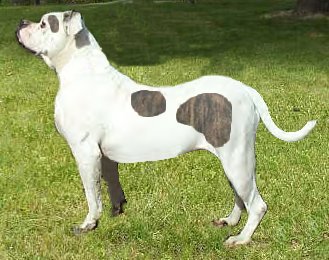 |
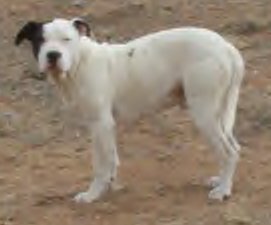 |
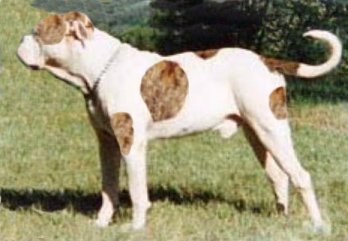 |
Legs:
Strong and straight with heavy bone. Front legs should not set too close together or too far apart. (see above pics)
Faults: In at the elbows or excessively bowlegged.(see above pics) Rear legs should have a visible angulation of the stifle joint.(see below pics)
 |
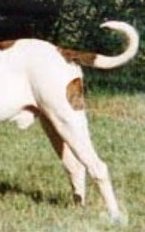 |
Hindquarters:
Very broad and well muscled and in proportion to the shoulders.
Narrow hips are a very serious fault.
|
|
|
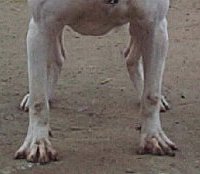 |
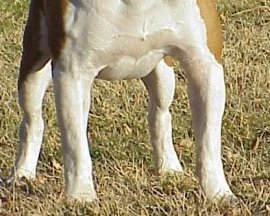 |
Movement:
The gait is balanced and smooth, powerful and unhindered suggesting agility with easy, ground covering strides, showing strong driving action in the hind quarters with corresponding reach in front. As speed increases the feet move toward the center line of the body to maintain balance. Ideally the dog should single-track. The top line remains firm and level, parallel to the line of motion. Head and tail carriage should reflect that of a proud, confident and alert animal.
 |
 |
Movement faults:
Any suggestion of clumsiness, tossing and / or rolling of the body, crossing or interference of front or rear legs, short or stilted steps, twisting joints, pacing, paddling, or weaving. Similar movement faults are to be penalized according to the degree to which they interfere with the ability of the dog to work.
Feet:
Of
moderate size, toes of medium length, well arched and close together, not
splayed. Pasterns should be strong, straight
and upright.
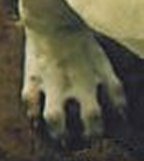 |
 |
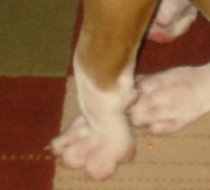 |
 |
Tail:
Set low, thick at the root, tapering to a point. Docked or undocked.
Tail should not curl over back. *A docked tail could hide faults. We also see screw tails in the American Bulldog.
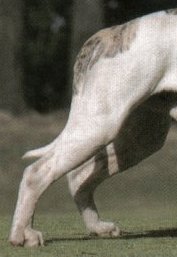 |
 |
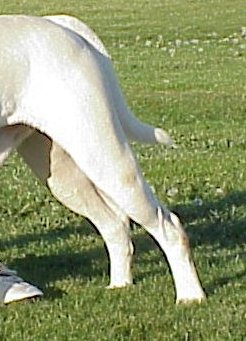 |
 |
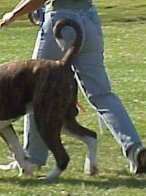 Curled over back
Curled over back |
 |
|
Coat:
Short, close, stiff to the touch, not long and fuzzy.
 |
 |
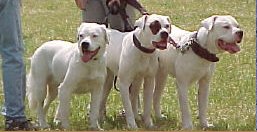 |
Color:
All white, pied, or up to 85% color with a portion of the white on the head. Brindle or red patches, red is defined as any shade of tan, brown or red. (brindle, red, or buckskin patches, if there is color on the head it should appear to be color on a white head.)
 |
 |
 |
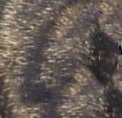 |
 |
 |
Disqualification’s:
Both types:
Dogs that are deaf or males without two testicles clearly descended.
Bully-type: an even or scissors bite.
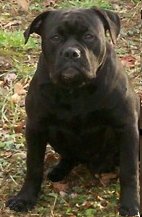 |
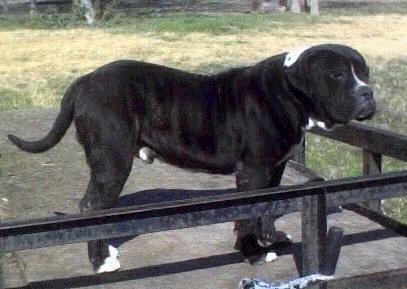 |
|
 |
Disposition:
Alert, outgoing and friendly with a self-assured attitude. Some aloofness with strangers and assertiveness toward other dogs is notconsidered a fault.
Fault Degrees:
A
cosmetic fault is one of a minor nature. A fault not specified as cosmetic
has to do with structure as it relates to a working dog. In a show or other
evaluation, the dog is to be penalized in direct proportion to the degree
of the fault. Any fault which is extreme should be considered a serious
fault and should be penalized appropriately.
Point Breakdown
for Judging:
Overall:
proportion 10 points
temperament
10 points
-------------------------------------
Total
of 20 points
Head:
size and shape 10 point
muzzle
5 points
teeth
5 points
---------------------------------
Total
of 20 points
Body:
neck 5 points
shoulders
5 points
chest
10 points
back
10 points
hindquarters
10 points
legs
10 points
feet
5 points
tail
and coat 5 points
------------------------------------
Total
of 60 points
Grand Total of 100 points
Note: The distinctions made between the Standard-type and the Bully-type depict an ideal representative of their respective types for show purposes only. At ABA shows, there are two rings ... A Standard Ring and a Bully Ring.
A
Summary of the Standard-type and Bully-type distinctions:
In
actuality, many American Bulldogs are hybrids between the Standard and
Bully type. The distinctions between the two types were made to allow separate
shows for Standard-types and Bully-types. Generally the Bully-type
distinction allows for a slightly larger dog and requires
a slightly (1/8 to 1/4 inch undershot lower jaw, but this distinction mandates
separate shows for the two types.
